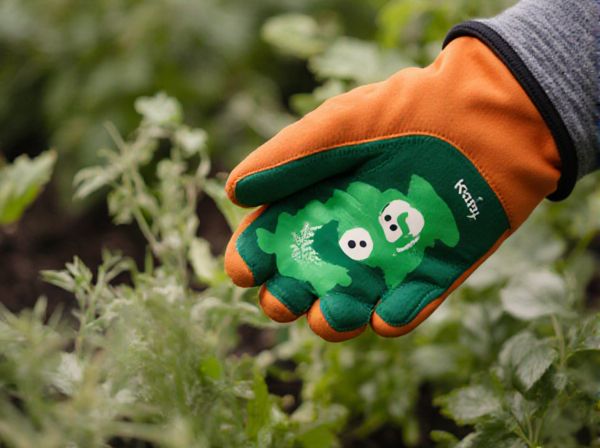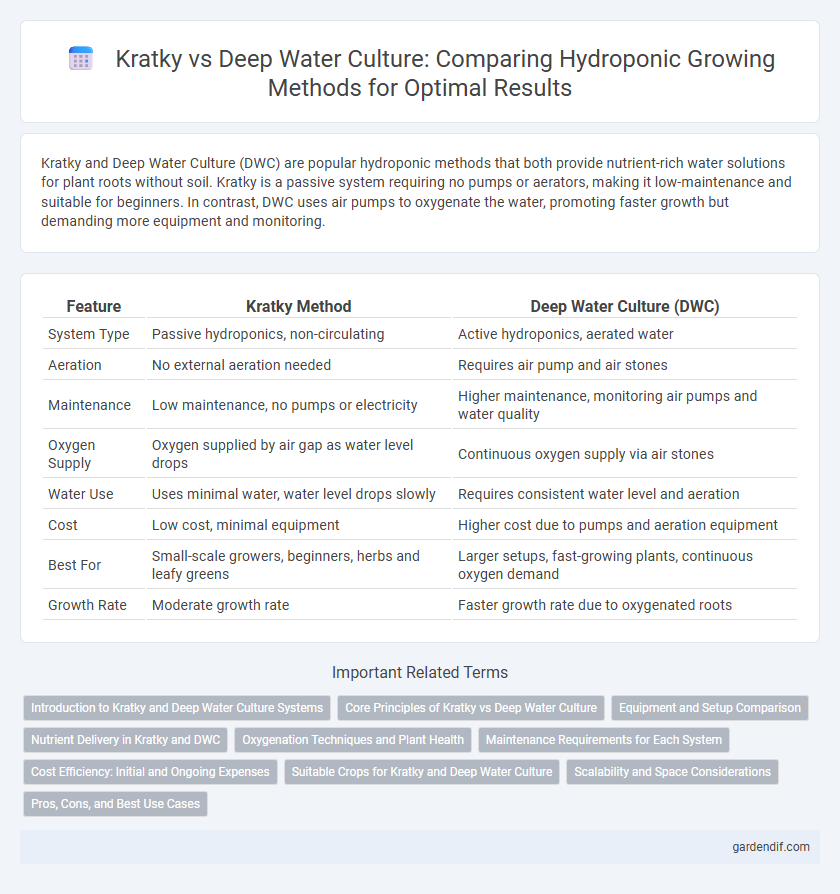
Kratky vs Deep Water Culture Illustration
Kratky and Deep Water Culture (DWC) are popular hydroponic methods that both provide nutrient-rich water solutions for plant roots without soil. Kratky is a passive system requiring no pumps or aerators, making it low-maintenance and suitable for beginners. In contrast, DWC uses air pumps to oxygenate the water, promoting faster growth but demanding more equipment and monitoring.
Table of Comparison
| Feature | Kratky Method | Deep Water Culture (DWC) |
|---|---|---|
| System Type | Passive hydroponics, non-circulating | Active hydroponics, aerated water |
| Aeration | No external aeration needed | Requires air pump and air stones |
| Maintenance | Low maintenance, no pumps or electricity | Higher maintenance, monitoring air pumps and water quality |
| Oxygen Supply | Oxygen supplied by air gap as water level drops | Continuous oxygen supply via air stones |
| Water Use | Uses minimal water, water level drops slowly | Requires consistent water level and aeration |
| Cost | Low cost, minimal equipment | Higher cost due to pumps and aeration equipment |
| Best For | Small-scale growers, beginners, herbs and leafy greens | Larger setups, fast-growing plants, continuous oxygen demand |
| Growth Rate | Moderate growth rate | Faster growth rate due to oxygenated roots |
Introduction to Kratky and Deep Water Culture Systems
Kratky and Deep Water Culture (DWC) are popular hydroponic systems designed for soil-less plant growth by delivering nutrients through water solutions. The Kratky method is a passive system relying on a non-circulating nutrient reservoir, making it low-maintenance and ideal for beginners or small-scale growers. In contrast, Deep Water Culture uses an aerated nutrient solution with oxygen supplied by air pumps, supporting faster plant growth and higher oxygen availability for roots.
Core Principles of Kratky vs Deep Water Culture
Kratky method relies on a non-circulating, passive hydroponic system where plants grow above a static nutrient solution, allowing roots to absorb oxygen from the air gap formed as water levels drop. Deep Water Culture (DWC) involves continuously aerated nutrient-rich water, using air pumps and diffusers to maintain oxygen levels for root respiration. While Kratky offers a low-maintenance, no-electricity approach ideal for small-scale setups, DWC demands active oxygenation but supports faster growth and larger plants through constant nutrient and oxygen supply.
Equipment and Setup Comparison
Kratky hydroponics requires minimal equipment, relying on a simple reservoir and net pots without pumps or aeration systems, making it ideal for low-maintenance setups. Deep Water Culture (DWC) demands more complex equipment, including an air pump, air stones for oxygenation, and a water reservoir to maintain continuous nutrient-rich water around the roots. The contrasting setups highlight Kratky's passive approach versus DWC's active aeration system, impacting both cost and oxygen availability for plant roots.
Nutrient Delivery in Kratky and DWC
Kratky method relies on passive nutrient delivery by suspending plant roots in a nutrient solution without active aeration or circulation, allowing roots to absorb nutrients as the water level gradually decreases. Deep Water Culture (DWC) employs continuous oxygenation and nutrient circulation through air pumps, ensuring a constant supply of nutrients and oxygen for rapid root uptake. Nutrient delivery in Kratky is simpler and low-maintenance, while DWC provides enhanced nutrient availability and growth potential through active aeration and solution movement.
Oxygenation Techniques and Plant Health
Kratky method uses a passive oxygenation technique where plant roots access oxygen from the air gap between the water surface and the plant base, ensuring sufficient root aeration without pumps. Deep Water Culture (DWC) employs active oxygenation through air stones or diffusers that continuously oxygenate nutrient water, promoting faster root growth and enhanced nutrient uptake. Adequate oxygenation in DWC often results in improved plant health and higher yields compared to the more static Kratky system.
Maintenance Requirements for Each System
Kratky hydroponic systems require minimal maintenance as they operate passively without pumps or aeration, relying on a static nutrient solution that reduces frequent monitoring. Deep Water Culture (DWC) demands more active maintenance, including regular oxygenation through air pumps and consistent monitoring of nutrient levels, pH, and water temperature to ensure optimal root health. The simplicity of Kratky makes it ideal for beginners or low-maintenance setups, whereas DWC suits growers seeking higher yields with more hands-on system management.
Cost Efficiency: Initial and Ongoing Expenses
The Kratky method offers significant cost efficiency with minimal initial investment, requiring no pumps or electricity, making it ideal for low-budget hydroponic setups. Deep Water Culture (DWC) demands higher upfront spending due to the need for air pumps, reservoirs, and continuous energy use, leading to increased ongoing expenses. For growers prioritizing affordability and simplicity, Kratky stands out as the most economical choice in both startup and maintenance phases.
Suitable Crops for Kratky and Deep Water Culture
Kratky method is ideal for growing leafy greens such as lettuce, spinach, and herbs due to its passive nutrient delivery system that suits low-maintenance crops. Deep Water Culture (DWC) is better suited for fast-growing and larger plants like tomatoes, peppers, and cucumbers, benefiting from constant oxygenated nutrient solutions. Crop selection directly influences growth rates and yield efficiency in hydroponic systems, making Kratky preferable for small-scale or beginner setups and DWC for more intensive production.
Scalability and Space Considerations
Kratky method offers superior scalability and space efficiency due to its passive, soil-less design requiring no pumps or aeration equipment, making it ideal for small to medium setups with limited space. Deep Water Culture (DWC) demands more space and infrastructure to accommodate continuous water circulation and oxygenation systems, which can challenge scalability in confined environments. For large-scale hydroponic farms aiming to maximize yield per square foot, Kratky provides a low-maintenance alternative that reduces operational complexity and spatial footprint.
Pros, Cons, and Best Use Cases
Kratky method excels in simplicity and low maintenance, requiring no pumps or electricity, making it ideal for beginners and small-scale hydroponic setups, but has limited oxygen supply which can restrict plant growth. Deep Water Culture (DWC) offers superior oxygenation with continuous air supply via an air pump, promoting faster growth and higher yields, though it demands more equipment, monitoring, and higher energy consumption. Kratky suits herbs and leafy greens grown in compact spaces, while DWC is best for larger, fast-growing crops like lettuce and basil in commercial or serious hobbyist environments.
Kratky vs Deep Water Culture Infographic

 gardendif.com
gardendif.com